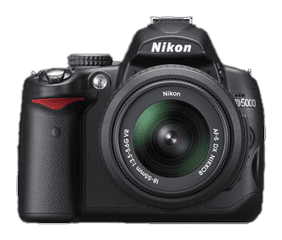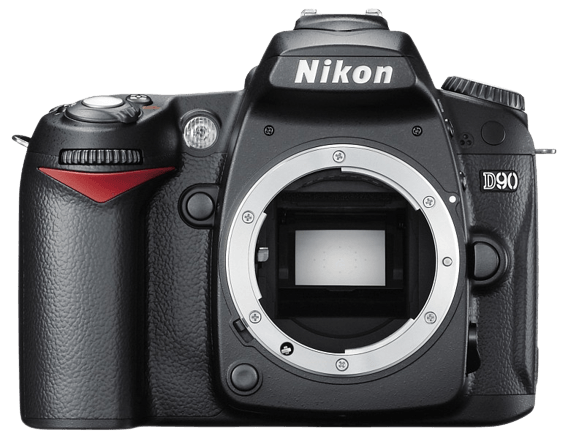Nikon D5000 vs D90 Comparison
Nikon D5000

Nikon D90

The Nikon D90 outperforms the Nikon D5000 with a score of 44/100 compared to the D5000’s 41/100. Both cameras are DSLRs, released in 2008 and 2009, respectively. They share similar dimensions, with the D90 measuring 132 x 103 x 77mm and the D5000 at 127 x 104 x 80mm. The D5000 is lighter, weighing 590g, while the D90 weighs 703g.
The D90’s higher score reflects its better performance, despite being an older model and having a higher launch price of $1235, compared to the D5000’s $730. On the other hand, the D5000’s advantage lies in its lighter weight, making it more convenient for some users. Considering these factors, the Nikon D90 is the superior camera, but the D5000 may be more suitable for those prioritizing weight and budget.
Nikon D5000 vs D90 Overview and Optics
The Nikon D90 wins the optics comparison with a score of 46/100, while the Nikon D5000 scores 45/100. Both cameras share several common specifications, such as 12.3 megapixels, a CMOS sensor, the Expeed processor, an APS-C sensor size, a Nikon F DX lens mount, and no image stabilization.
The D90 surpasses the D5000 in two aspects: shooting speed and DXOMARK score for the sensor. With a shooting speed of 4.5 frames per second (fps), the D90 has a slight edge over the D5000’s 4 fps, making it more suitable for capturing fast-moving subjects. Additionally, the D90’s sensor has a DXOMARK score of 73, one point higher than the D5000’s score of 72. This indicates that the D90’s sensor performs marginally better in terms of color depth, dynamic range, and low-light performance.
While the D5000 falls short in those two areas, it does not possess any specific advantages over the D90 in terms of optics. The one-point difference in the overall score is solely due to the D90’s slightly better performance in shooting speed and sensor quality.
Taking these factors into account, it is clear that the Nikon D90 is the better camera in terms of optics. The higher score of 46/100 reflects its advantages in shooting speed and sensor performance. The Nikon D5000, with a score of 45/100, remains a worthy contender but does not offer any optical benefits over the D90. Potential buyers should consider these differences when deciding between the two cameras.
Nikon D5000 vs D90 Video Performance
When comparing the video capabilities of the Nikon D5000 and the Nikon D90, it is essential to note that the Nikon D90 does not have any video functionality. Thus, the remainder of this comparison will focus on the video capabilities of the Nikon D5000.
The Nikon D5000 has a video score of 49 out of 100. The camera offers a maximum video resolution of standard HD, with dimensions of 1280 x 720 pixels. This resolution is suitable for casual video recording and sharing on social media platforms. The D5000 also supports a maximum video frame rate of 24 frames per second (fps), which is a common frame rate for cinematic video recording.
One notable feature of the Nikon D5000 is its built-in time-lapse functionality. This feature allows users to create stunning time-lapse sequences directly within the camera, without the need for additional software or equipment.
Considering the video capabilities of the Nikon D5000 and the lack of video functionality in the Nikon D90, it is clear that the D5000 offers more versatility in terms of video recording. Users who prioritize video recording alongside photography will find the Nikon D5000 to be a more suitable option.
Nikon D5000 vs D90 Features and Benefits
The Nikon D90 outperforms the Nikon D5000 with a feature score of 41/100 compared to the D5000’s 34/100. Despite their differences, both cameras share several specifications, including the absence of a touchscreen, flip screen, GPS, WIFI, and Bluetooth.
The Nikon D90 surpasses the D5000 in terms of screen size and resolution. With a 3-inch screen and a resolution of 920,000 dots, the D90 provides a more comfortable and detailed viewing experience than the D5000’s 2.7-inch screen and 230,000-dot resolution. This advantage allows photographers to better compose their shots and review images on the D90.
Although the Nikon D5000 has a lower feature score, it does not necessarily mean it lacks any advantages over the D90. However, in this comparison, the D5000 does not show any significant benefits over the D90 in terms of features. Both cameras have the same limitations and share the same specifications, as mentioned earlier.
Considering the information provided, the Nikon D90 holds a clear advantage in features with its larger screen and higher resolution. This makes it a better choice for those who prioritize image composition and review. The Nikon D5000, on the other hand, does not offer any notable benefits in this comparison. It is essential to consider other aspects, such as general specifications, optics, and video capabilities when making a final decision.
Nikon D5000 vs D90 Storage and Battery
The Nikon D90 outperforms the Nikon D5000 in storage and battery with a score of 37/100, compared to the D5000’s 27/100. Both cameras share the same storage specifications, featuring one memory card slot and accepting SD/SDHC cards. However, the D90 surpasses the D5000 in battery life, offering 850 shots per charge, while the D5000 provides 510 shots. This difference is due to the D90 using the EN-EL3e battery type, while the D5000 uses the EN-EL9a. Neither camera supports USB charging.
The D90’s longer battery life makes it a more convenient option for extended photography sessions, reducing the need to carry spare batteries or recharge frequently. On the other hand, the D5000 does not offer any advantages in storage and battery over the D90.
Considering these factors, the Nikon D90 proves to be the superior choice in terms of storage and battery performance, making it more suitable for photographers who require longer shooting times without interruptions.
Nikon D5000 vs D90 – Our Verdict
Are you still undecided about which camera is right for you? Have a look at these popular comparisons that feature the Nikon D5000 or the Nikon D90:
